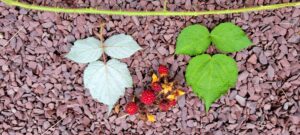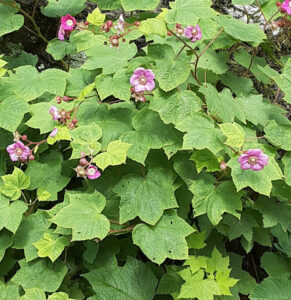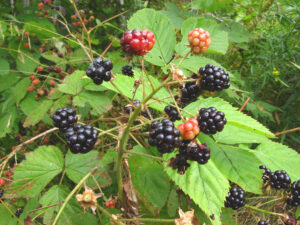It’s that time of year at MCR where many delicious brambles species are in fruit!
What is a bramble you say, well bramble is a common name given to the Rubus genus of plants of the rose family. Still don’t know what a bramble is, well most of these plants have woody stems with prickles like roses; spines, bristles, and gland-tipped hairs along their stems which are called “canes” and produce a fruit that is an aggregate of drupelets (i.e. an outer fleshy part surrounding a single shell a seed inside).
Still not sure, well how about this, some examples are raspberries, blackberries and wineberries.
At Merrill Creek we have two native brambles, Purple-flowering Raspberry and Common Blackberry (also called Allegheny Blackberry). But by far the dominant bramble we have here at MCR is an exotic introduced species that has become very invasive. This invasive non-native species is the Wineberry.
Wineberry (Rubus phoenicolasius) is an Asian species of raspberry in the rose family, native to China, Japan, and Korea. The species was introduced to Europe and North America as an ornamental plant and for its potential in breeding hybrid raspberries. Wineberry can form dense thickets that can cover large areas, crowding out native plants like brambles, raspberries, and blackberries. Wineberry’s growth period is different from native plants, allowing it to come up earlier and last longer. It’s also more tolerant of different light, soil, and moisture conditions than native plants. A study by the Vermont Agency of Agriculture found that, “wineberry can alter soil properties, reduce native plant diversity, and disrupt ecosystem processes, such as nutrient cycling. Furthermore, its ability to spread rapidly through both seed dispersal (mostly by birds and mammals) and vegetative reproduction exacerbates its ecological threat.”
How to identify Wineberry and other brambles at MCR:
Wineberry: Like raspberries, wineberry has silvery underleaves, a fruit core that remains on the stem when the ripe fruit is picked, and thorns. It is differentiated from other raspberry species by the fine red hairs that grow densely on its stems (and flowers) causing a reddish hue to the plant. Wineberry fruit is vibrantly red when ripe, which helps differentiate it from native black raspberries and blackberries; it also has three leaflets per leaf rather than five, which separates it from many blackberry species. Unique to wineberry is its small, greenish, hairy flowers with white petals and the way its fruit remain covered by sepals (greenish petal-like structures) until almost ripe.
Purple-flowering raspberry (Rubus odoratus): Purple-flowering raspberry has maple-shaped leaves that are soft and hairy; leaves not silvery; flowers pinkish-purple. Fruit is flatter and fuzzier than a raspberry, forming more of a cup shape.
Alleganey Blackberry (Rubus allegheniensis): Alleganey blackberry commonly forms broad colonies. Erect branches become arching. Stem is purplish-red and armed with large thorns. Dark green summer foliage is palmately or pinnately compound, becoming orange, red and purple in fall. Loose, terminal clusters of five-petaled flowers are followed by thimble-shaped, raspberry-like, black berries.
- Don’t bring your pets – no one likes pet droppings or urine on a berry.
- Don’t pick unripe berries – let them mature.
- Don’t wear your fanciest shoes or outfit – you will inevitably get dirty and/or stained.
- Don’t pee where you pick – see rule one because it goes for humans too!
- Always wash your fruit when you get home BEFORE you eat it -you never know what is, or has been, on fruit in the wild.
- Don’t overpick – leave some for the next person and animal.
- Don’t take all your berries from one plant, pick a few from one and a few from another – leave some on different plants for genetic diversity!
- Be aware of your surroundings -you are not the only one that likes delicious berries. So do bears, raccoons, opossums, and other animals who will frequent berry patches, as well as snakes as they will lie and wait for rodents that come to eat the berries.




